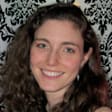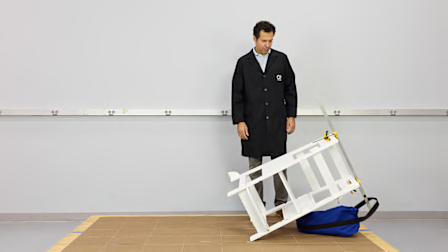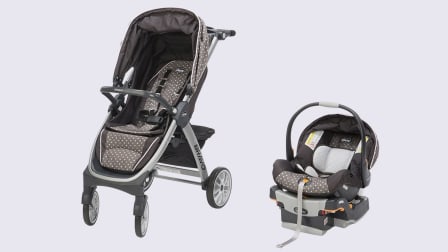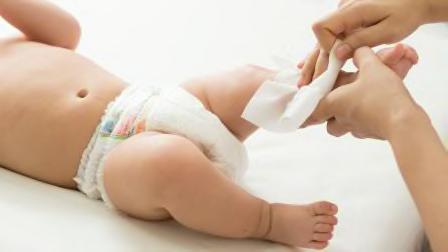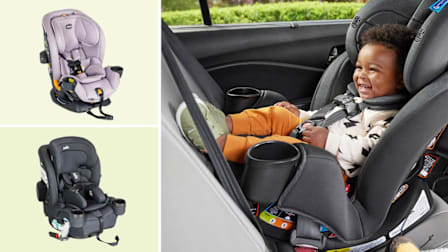Government Moves Closer to Stopping the Sale of Dangerous Baby Sleep Products
The action includes inclined and in-bed sleepers. Consumer Reports advises caregivers to immediately stop using these products for sleep.
Update: On June 2, 2021, the Consumer Product Safety Commission voted 3 to 1 to approve a final rule to require that all products sold and marketed for infant sleep meet established safety standards for sleep products.
The Consumer Product Safety Commission, the federal agency that oversees thousands of household products, is meeting today to discuss a draft rule that, if approved, would effectively eliminate from the marketplace several types of unsafe or potentially hazardous sleep products meant for babies up to 5 months old.
That includes inclined sleepers, which position babies at an angle of greater than 10 degrees, and in-bed sleepers, which are intended or marketed for parents who want to share their bed with their babies. Together, these kinds of products have been linked to dozens of infant deaths.
CPSC staff has delivered a strong recommendation (PDF) in favor of the new rule. But it cannot go into effect without a majority of CPSC commissioners approving it. They are expected to vote June 2, 2021.
Filling a Safety Gap
The new rule is meant to fill a gap in the CPSC’s oversight of infant sleep products.
Currently, only five categories of infant sleep products must meet mandatory safety standards before they can be sold: full-sized cribs, non-full-sized cribs, bassinets/cradles, play yards, and bedside sleepers. These products must adhere to strict requirements and must be safety-tested by a third party to ensure that they meet their respective standards before they can enter the marketplace. For example, the products’ sleep surface cannot have an incline of greater than 10 degrees, and the products’ sidewalls must be firm and measure at least 7.5 inches high. These design features help prevent babies from hazards such as suffocating and falling.
The new rule would mandate that any product marketed for infant sleep must adhere to one of these five safety standards; otherwise, the product will not be allowed on the market.
As CR has previously reported, exemptions to these standards have had fatal consequences. In 2010, Fisher-Price asked the CPSC to carve out its newly created inclined sleeper, the Rock ’n Play Sleeper, from the bassinet standard—a request the agency granted.
As a result, the company worked to create a voluntary standard for infant inclined sleep products, through ASTM International, an independent standard-setting organization that oversees thousands of voluntary product standards.
But unlike infant sleep products governed by mandatory standards, inclined sleepers were not adequately safety tested before going to market. And as more families used the products, more infant fatalities were linked to them. It wasn’t until April 2019, after CR uncovered dozens of infant deaths tied to the products and outlined the inherent risks of the sleepers, that Fisher-Price and several other inclined sleeper manufacturers recalled the products.
The existence of some products, such as bassinets, that have to meet safety standards, and others, such as inclined sleepers, that do not, has long confused consumers. Many assume that all products that are widely available for sale and marketed for overnight sleep and naps must be safe for sleeping babies.
“Most of us assume that if something is sold, that it has been proven to be safe,” says Hoffman at the AAP. “Sadly, this is not always the case, and the presence of dangerous infant sleep products on the market is an example that puts babies at risk, and can lead to tragedies.”
Sara Thompson, whose 15-week-old son Alex died in an inclined Fisher-Price Rock ’n Play Sleeper in 2011, says she had no idea the product would put her child at risk. “Had I been aware of the danger, I never would have opted for the inclined sleeper, and I would have strictly used the crib,” she says. “I trusted the company, and that’s a mistake I’ll never make again.”
In-bed sleepers are also not covered by a mandatory standard. These products are designed to be placed on an adult bed so that caregivers can sleep next to their infants. But safety advocates have noted that the products are often padded, do not have a firm, flat sleep surface, and do not have sidewalls that are high enough to prevent babies from rolling out. (DockATot recently stopped advertising its product as a sleeper, describing it as a product meant for supervised lounging or playing instead.)
Makers of in-bed sleepers are currently hoping to create a voluntary standard for their products, similar to what Fisher-Price did for inclined sleepers.
The new rule, however, would thwart that goal. In fact, the proposed language in the rule notes says the agency staff does not want “a repeat” of what happened when inclined sleepers were allowed to stay on the market first without any standard and then with a voluntary standard. “We note the development of infant inclined sleep products as a prime example of innovation preceding safety,” the CPSC staff states in the draft rule.
The agency staff states that it took many years for ASTM to establish a voluntary standard for infant inclined sleepers, and as "time went on, the hazards posed by inclined products became apparent in the accumulation of infant deaths and incidents.”
The rule also notes that a product’s messaging must be clear. In the briefing package, it states that “product packaging, marketing materials, inserts, and instructions cannot indicate that the product is for sleep, or imply through pictures of sleeping infants that sleeping in the product is acceptable, [and the] product name, description, and instructions also cannot include references to sleep, snooze, dream, or nap.”
Thompson notes that clear marketing would be particularly helpful for sleep-deprived parents. “I think for new parents researching sleep options, this rule will make a significant impact on their decisions,” she says. “It would mean no more questionable marketing ploys showing a baby sleeping but then saying the product is not for sleep in small print on a hidden tag.”
The AAP’s Hoffman agrees: “I think implementation of this rule will help make it easier for parents and caregivers by removing dangerous options from the marketplace, and ensuring that safe products are front and center.”
The Juvenile Products Manufacturers Association, a trade organization whose members include makers of in-bed and inclined sleepers, said that it “supports requirements” that sleep surfaces be no greater than 10 degrees, but stated in a letter to the CPSC that a vote on the draft rule as written would be premature because the group believes further analysis is needed of other sleep products that would be included.
A Baby Delight spokesperson said that the company could not comment on the CPSC’s draft rule until after a final vote. DockATot did not respond to CR’s request for comment.
What’s Next
The CPSC commissioners are scheduled to vote on the new rule June 2, 2021. If a majority approves, the rule would go into effect a year after it’s finalized, and it would have a significant impact on the industry.
“Manufacturers would finally be accountable for addressing risks they have been downplaying for years,” says CR’s Shin. “The rule would draw a clear line between infant products for sleep and infant products not for sleep. Companies would not be able to market their products in ways that confuse parents and put babies at serious risk.”
This could cause some companies to stop making their sleepers; other companies may choose to reposition their sleepers as products meant for supervised play time instead.
“Sleeping babies are at greater risk in products that don’t align with expert medical recommendations, and the CPSC staff are right to insist that any infant sleep product meet strong, binding safety standards,” Shin says.
Update: The Consumer Product Safety Commission voted 3 to 1 on June 2, 2021 to approve a final rule to require that all products sold and marketed for infant sleep meet established safety standards for sleep products.
















